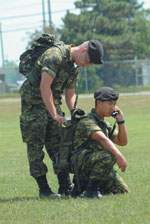Canada's Communication Reserve Links Warfighters
 |
| Members of the Canadian Communication Reserve prepare to begin a reconnaissance mission to find new locations or radio detachments and to lay telephone lines to the locations. |
As with the U.S. military, Canada is transforming its military to enhance network-centric operations and to improve information security. And, also similar to the United States, the Canadian Forces are counting on their reservists to shore up their ranks in current operations as well as in homeland security. Changes taking place today and plans for the future will align reservists better with their active duty counterparts and increase the expertise they bring to the battlespace. Communication reservists, who are already playing an active role, are likely to see their contributions to national security expand in the near future.
The Canadian Forces comprise the regular force and the reserve force. The Primary Reserve, one of four components of the reserve force, includes the Army Reserve, Naval Reserve, Air Reserve, National Defence Headquarters Primary Reserve List and Communication Reserve. Currently, the Communication Reserve has 2,000 troops. While some regular force members are part of the Communication Reserve, the majority of the formation is made up of reservists.
Col. Christopher J. Weicker, CF, commander, Communication Reserve, explains that his organization is subdivided into five communications groups located across Canada: British Columbia, the Prairie Provinces, Ontario, Quebec and the Atlantic Provinces. Each group comprises three to seven units for a total of 23. One of the units is unique in that it focuses on electronic warfare, the colonel says.
“The Communication Reserve has several jobs. One is to generate forces—similar to the Americans where the commander of the army generates forces and then the component commanders actually employ them. We generate combat-ready troops in two fields: information operations and communication and information systems. We provide anywhere from 35 and 50 people to the regular force for overseas operations. Right now, I have 39 reservists overseas or preparing to go overseas. In terms of supporting the regular forces, we go anywhere the regular force goes,” Col. Weicker relates. Reservists are in Bosnia and Afghanistan, and nearly half of the reservists supporting operations overseas are in the Golan Heights, he adds.
The Communication Reserve also supports the regular force in domestic operations. Because Canada does not have a force equivalent to the National Guard in the United States, the country relies on its regular and reserve forces during national emergencies such as forest fires, floods and ice storms, the colonel explains.
Although these reservists typically work part time, they can be called upon to augment the regular force in a full-time position. In general, this occurs when a position cannot be filled with active duty personnel. Currently, nearly 10 percent of the members of the Communication Reserve have been “called out” to active duty, Col. Weicker allows.
In addition to supplementing the regular force, the Communication Reserve assists the other Primary Reserve components. For the army, it provides training detachments and complete signal squadrons for exercises; for the navy, it provides the land-based headquarters for domestic operations such as natural disasters. The colonel notes that communication reservists also are aiding the Naval Reserve with increased national security efforts particularly in ports and on shared borders. “In the next six months, you will see a huge increase in visibility in national security in the Canadian Forces. The new chief of the Defence Staff has articulated where we will go in domestic operations. Basically, he stated that we will treat Canada as an operational theater, which means that we will treat Canada as any other theater overseas, put in the necessary command and control structures, and work closely with the Americans to defend the continent,” he reveals.
The Communication Reserve is the primary organization for providing combat-capable information technology and management services to all of the Canadian forces as well as links to civilian communities throughout the country. Col. Weicker explains that the reservists involved in communication and information systems provide national command and control and information system detachments. Among the technologies these detachments employ are satellite communications and high frequency radio capabilities. They also can set up small, strategic message centers by deploying a single, small vehicle. Called the Quick Reaction Terminal, the vehicle features both high frequency radio and Inmarsat communications capabilities. These 30 light detachments operate in a high-readiness state and can be on location and operational within hours.
The Tactical Command, Control and Communications System project provides integrated, secure, survivable and responsive communications for the Canadian Land Forces. The colonel notes that a new communications capability called the Integrated Radio and Intercommunications System, or IRIS, features voice and data short- and medium-range tactical communications capabilities.
Together, these two systems allow the Communication Reserve to set up command posts. For example, in a domestic operation, the organization would first send in reservists with the Quick Reaction Terminal as the satellite link then bring in additional reservists to support the regular force conducting the operations, he explains. The mainstay personnel for these tasks are the signal operators and the linemen, he adds.
The colonel allows that the reserve units and regular force units are configured similarly. However, domestic operations are a priority for the Communication Reserve because the regular force may not be available as first responders.
The Communication Reserve also provides support to international operations primarily in the Canadian Forces Joint Signal Regiment. Reservist training is identical to training for the regular army, and 60 percent of the time these reservists will deploy overseas in a strategic communication detachment. They also can support the regiment with domestic operations.
Although electronic warfare has been part of the current reserve force structure for some time, information operations are a relatively new focus for the Communication Reserve, and work in this area is going to increase in the future, the colonel says. To raise the priority level of electronic warfare in the Communication Reserve, the organization is aligning the military occupation code (MOC) for reservists so it is equivalent to the communication research operator military occupation in the regular force. On the tactical side of information operations, the reserve’s electronic warfare squadron will be equivalent to the 2 Electronic Warfare Squadron in the regular force.
 |
| Two reservist signal operators test a very high frequency backpack radio configuration. |
In addition to this effort, this summer the Communication Reserve will conduct a pilot program that involves five detachments across Canada that will recruit people with linguistic skills. “It is a very exciting program because if it works, which I’m sure it will, it could be an area of growth in the future. In my opinion, I think that in five to 10 years there will be more emphasis in these types of information operation capabilities,” he says.
Another field of emphasis for the Communication Reserve is information protection, and the organization has worked with the United States in this arena. The colonel notes the recent creation of the Communication Reserve Information Protection Teams. Headquartered in Halifax, this virtual organization comprises five teams and will be in charge of the five linguist recruiting detachments. The teams have been working closely with the Canadian Forces network operating center. Last fall, they met with the U.S. Air Force Reserve in Tacoma, Washington, and they plan to expand the collaboration in the future.
The relatively small size of the Communication Reserve poses some challenges, the colonel allows, but sometimes it triggers ingenuity because the organization must acquire capabilities without the benefit of a large budget. For example, reservists were looking for a handheld scanner for checking network security. After determining that the cost of commercial products was prohibitive, three reservists in Halifax designed their own scanner by using Linux on an iPod. They created a handheld device that can scan any wireless network unobtrusively and determine what is being transmitted from a security standpoint. In addition, reservists are assigned to review public Web sites such as those hosted by the Department of National Defence to ensure the information is consistent with information release policies. “And it costs a fraction of what the commercial off-the-shelf product would have cost,” Col. Weicker notes.
In April 2004, the Communication Reserve unveiled its strategy for the immediate future. A tiger team developed the Communication Reserve Development Plan 2004-2009, which identifies future requirements. The plan also describes force goals through 2009 and outlines the steps that should be taken to achieve the objectives.
The colonel relates that many major changes outlined in the plan already have taken place since the beginning of 2004. “We took a complete look at our capabilities and rationalized the organizational structure so that it is now standard,” he says. The goal, Col. Weicker shares, was to minimize the resources spent on overhead and to maximize the resources for training, recruiting and retention. By standardizing the size of the groups, overhead costs were made consistent across the board, and expenditures dropped from 20 percent of the total budget to 15 percent of the total budget, he says.
Changes in the Communication Reserve’s electronic warfare unit constitute the second area that has demonstrated progress in achieving the plan’s goals. Col. Weicker maintains that the unit is getting closer to integrating with the regular forces unit, and the intention is to move the two to the same facilities during the next two years. “The advantage is that, as time progresses, we can’t afford to have two sets of equipment, for example, so sharing the facilities and resources increases effectiveness. But more importantly, this ensures that the reservist, who is part time, is trained to the same standard as the regular force and is using the same equipment,” he offers.
Related to this change was the decision to convert the MOC in the reserve’s electronic warfare squadron from a signal operator, or R215, to a communication research operator, or R291. Training has been modularized, so reservist and regular force training is the same; however, because of availability, the courses may take a reservist longer to complete. This new training approach also is being used with linemen, the colonel says.
Another change taking place involves support and maintenance of information systems, the colonel allows. In the past, the Communication Reserve had a technician trade, but as tactical communication system maintenance has moved to the commercial sector, and the required training in this area has increased, the organization decided it was not cost-effective to continue training reservists in this area. As a result, the program is being phased out, and the Communication Reserve will rely on contractors and the regular force to provide technical support, Col. Weicker says.
Training is an important part of the Communication Reserve, so each of the five communications groups is designated as a center of excellence for different capabilities, Col. Weicker reveals. The Prairie Provinces are the center of excellence for tactical communications. The British Columbia communications group is the center for support to the navy. Ontario focuses on electronic warfare and signals intelligence. Quebec specializes in strategic communications and the Quick Reaction Terminals. And the Atlantic Provinces are the center of excellence for information protection and information operations, including linguists.
The configuration provides a central contact point for a topic so the other groups can train with those specialists or contact a center when they need information in that area. “This ensures that there is cross-pollination and synergy between people. Each group has standards in training because when we deploy overseas, people come literally from all over Canada into a detachment, so we need to train in peacetime as we will operate in war,” the colonel states.
The Communication Reserve held its first training event in early February in Edmonton for 300 reservists who were brought in from throughout Canada. The topic was tactical communications, and Col. Weicker characterizes it as very successful. It demonstrated that the centers-of-excellence approach helps standardize training in areas such as deployment, standard operating procedures and cryptology. “We now have 300 people across 23 units who are at the same level of understanding at the operator level,” he notes. Similar training events have taken place in each of the other centers of excellence, and annual training events will take place to maintain proficiency, the colonel shares.
Col. Weicker predicts radical changes in the way the Canadian Forces operate in Canada and overseas in the future. “And we are well placed to support that,” he says.
Web Resources
Canadian Communication Reserve: www.img.forces.gc.ca/commRes/index_e.htm
Canadian Forces Reserve Structure: http://www.airforce.forces.gc.ca/air_reserve/organization/cf_structure_e.asp
Department of National Defence, Canada: www.forces.gc.ca/site/home_e.asp




Comments